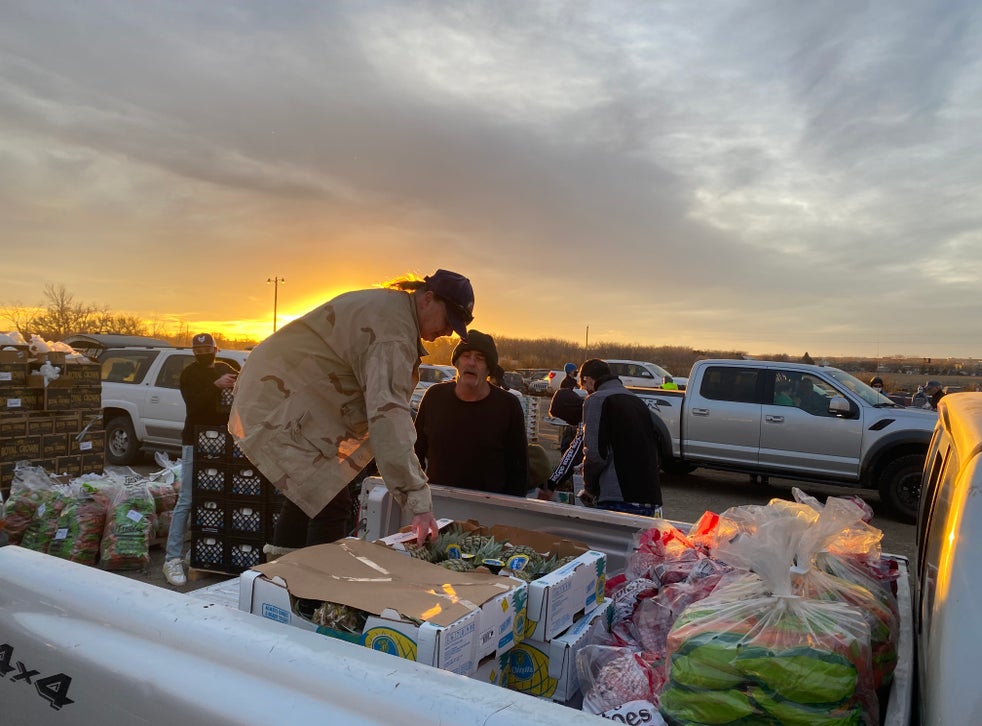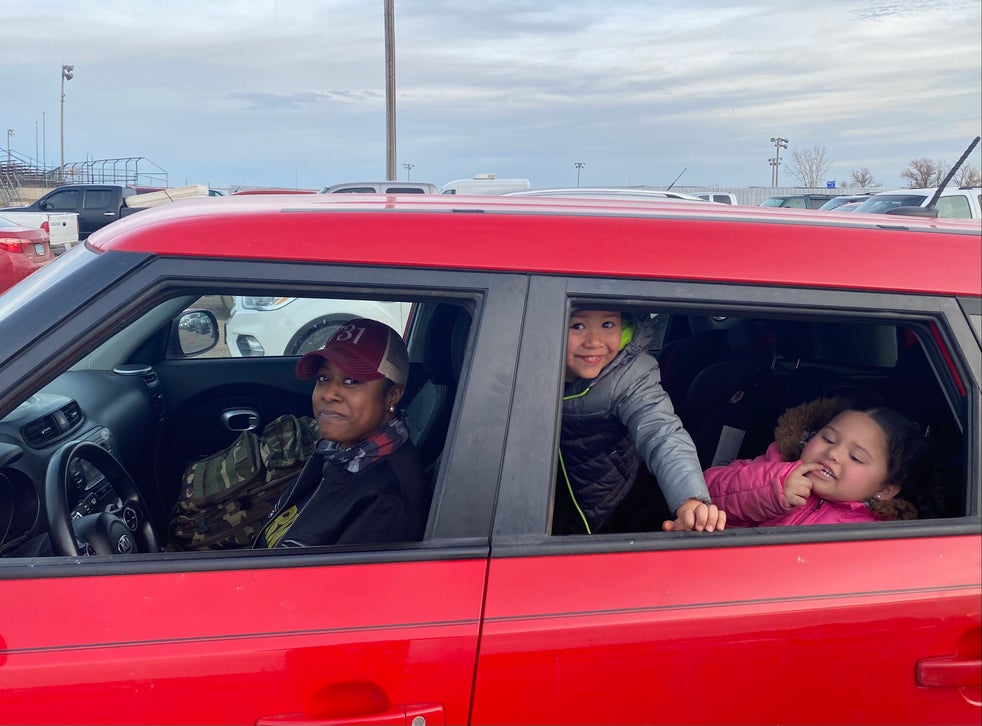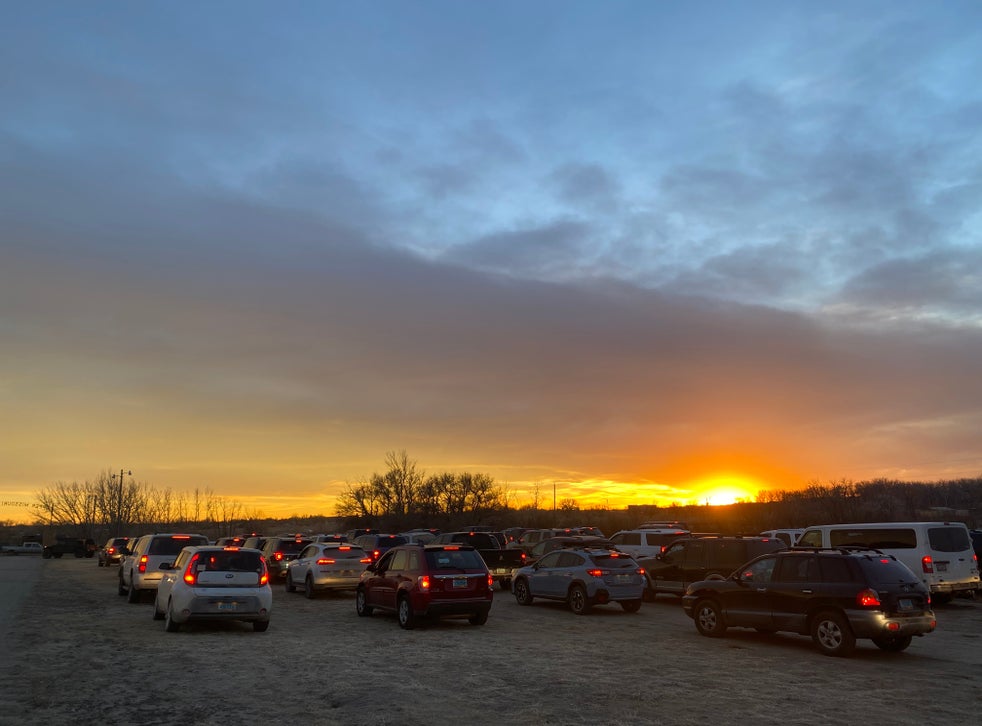Rural America’s hidden hunger: Mobile food banks travel for hundreds of miles to reach ‘food deserts’
Families are starving in ‘the breadbasket of America’, Richard Hall reports from Williston, North Dakota
“Sometimes I don’t understand either,” she says, looking out at the hundreds of cars lined up, “because it’s like how in the United States can we have this many hungry people?”

Barbara Doughtie loads boxes of food onto her truck at a mobile food bank in Williston, North Dakota
(Richard Hall/The Independent )
The cars arrive just as the sun is setting over the town of Williston, North Dakota. Hundreds of them roll slowly into the gravel parking lot of the Upper Missouri Valley Fairgrounds under a burning orange glow. They park dutifully in rows and wait with engines running and heaters on. In some of them, children crawl restlessly on the back seats. Others have come alone, straight from work.
Soon after a large white truck arrives. It has made a six-hour journey across the entire length of the state from Fargo with its precious cargo. In this isolated town, the food bank comes to them.
Hunger is rising in rural America. Travelling food banks like this one have become increasingly common since the onset of the coronavirus pandemic. They aim to service so-called “food deserts” – isolated areas far from organisations and charities that support people in need.
The Great Plains Food Bank, which covers North Dakota and western Minnesota, says it has seen a nearly 50 per cent increase in people seeking its help since March, when the economic downturn sparked by the pandemic began to bite. That rise has been particularly pronounced in rural towns like Williston.
“In the rural economy, if they're losing hours or have been laid off, there isn’t always somewhere else for them to go and work and get employed very quickly. So they’re really struggling,” says Melissa Sobolik, the organisation’s president.
What makes the rise in North Dakota so jarring is that the state has historically had low food insecurity. The Red River Valley is nicknamed the “breadbasket of America” for its abundance of wheat farms. That history and tradition has clouded the difficulties faced by many families today. “I grew up on a farm and there’s definitely a mindset when you’re a farmer and you grow food that, if you feed the world, you don’t expect that you need help feeding your own family,” says Sobolik.
“I think that it has always been a little under-reported in North Dakota because people don’t want to admit that they needed the help or that they didn’t perceive themselves as food insecure if they got help from family or friends.
“When people think of hunger, they think it’s an urban problem. They’re maybe thinking of homeless people and they’re also seeing big long lines in urban areas on the news,” she adds.
Hunger hits rural America
As the evening light dims further still, a team of volunteers unloads the cargo from the truck and begins to form an assembly line. The food packages, sourced from vendors in Fargo, are made up of simple staples; eggs, milk, potatoes, fruit and vegetables.
While one team unloads, another fans out into the field of vehicles to ask each waiting driver how many boxes they need. A number is drawn on the windscreen so they can glide through the assembly line without leaving their car when their time comes. They open their trunk and the food goes in.
The length of the lines at the food bank have grown and shrunk through various stages of the pandemic. Rachel Monge, a regional coordinator for the food bank who is overseeing the operation in Williston, says there was a surge of people seeking food assistance in March when the coronavirus first arrived in North Dakota. Over the summer, a combination of falling infections, unemployment benefits and stimulus checkers saw the lines grow shorter. But as winter came around and coronavirus cases rose again, so did the lines.
“Now we’re really seeing it ramp up again,” she says. “A lot of people were expecting to go back to their jobs and still haven’t because the numbers for Covid numbers have increased.”

A volunteer loads food onto a truck at a mobile food pantry run by the Great Plains Food Bank in Williston, North Dakota
(Richard Hall/The Independent)
Williston was already struggling before the pandemic arrived. The town witnessed an oil boom between 2006 and 2012, which fuelled rapid growth as workers came from across the country for high wages. When that boom ended, jobs began to retreat.
Here in Williston, the Great Plains Food Bank would typically deliver food to around 300 families; that has now risen to above 800. The food bank runs similar mobile deliveries to rural areas across the state, which are seeing a marked rise in hunger. When it finished its delivery here, the white truck went on to a nearby town to deliver 200 more boxes. Many are using the service for the first time.
Feeding America, the country’s largest hunger relief organisation, released a report this summer that food insecurity had risen by 77 per cent in North Dakota, albeit from a low starting point. Three of the five top counties with the largest increase were found in rural parts of the state – Burke County (157 per cent), Renville County (131 per cent), and Dickey County (127 per cent).
Researchers cited a host of reasons why rural communities were particularly hard hit by hunger during the pandemic, among them isolation, higher rates of unemployment, lack of access to grocery stores and higher food prices.
But even when food banks do come to these towns, people are unsure if they are eligible. It is an unfamiliar problem, according to Monge.
“I heard from a lady the other day, she said she lives 13 miles out in this rural community and she’s like: ‘Who is this for? Can I come?’ She says she often needs to not buy medication for her inhaler to make her food budget last. So here was this lady calling to see if she could come and I was like, oh my gosh, you should be first in line.”
There is no one type of person who uses the food bank. For some, it is a desperately needed lifeline. For others, it is a little extra help.
“Hunger doesn’t have a face,” says Monge. “Most often it’s hard-working people. It’s people with jobs. Oftentimes four-person families that don’t make enough or they only have one car so only one person can work because there’s not good enough public transportation.”

Deidra Heid, 29, and her two children, wait in line at a mobile food bank in Williston, North Dakota
(Richard Hall/The Independent )
For 29-year-old army veteran Deidra Heid, who is waiting in the queue as her two children climb around in the back, it wasn’t just one thing that brought her here.
She and her husband left the military in 2017 and he was offered a job in the oil industry in Williston. They moved from Georgia, where they were stationed, but when the pandemic hit his hours were cut dramatically. To make matters worse, he was forced to quarantine after coming into contact with someone who contracted Covid.
“We didn’t have the means to really quarantine because I have to watch out for our daughter. You can’t just tell people with kids to do that. She’s five, and I had to pull her out of school. It’s just a lot,” she says.
Heid enrolled in college to pursue a criminal justice degree, leaving her husband as the family’s sole breadwinner. So his work trouble put them in a bind.
“Just that little two weeks set us back,” she says. “It’s just stress coming from everywhere. I’m smiling right now to keep from crying, but it’s been real bad.”
Once the assembly line is up and running, the volunteers move quickly to finish before night falls. The lines snake so far back that cars cover both sides of the road that runs through the large parking lot. Some are occupied by a single driver, others by whole families.
Barbara Doughtie is here with several trucks to pick up for 60 people at her housing authority, most of whom are seniors or people with disabilities who can’t go out.
“There are jobs here but a lot of them are part-time. They aren’t full-time anymore. Everybody needs help. The pandemic has cut everybody down,” she says. “Everybody uses the Salvation Army food bank. Everybody. It’s full every day.”
“Nobody goes out as much as they do. They don’t shop as much as they used to. This helps us because we don’t have to get out of our vehicles,” she adds.
Maria Adkins, 30, is waiting with her four children. She has a similar story of a temporary setback that put her on the back foot.
“Right now money is a little tight. We got pay cuts, then we lost a job – my husband was out of work for three weeks. And that’s on top of other issues, like we just had a fire in our house. We lost a lot of stuff,” she says.
“So this food, it helps, especially when you’ve got young kids,” she adds.

The lines snake so far back that cars cover both sides of the road that runs through the large parking lot
(Richard Hall/The Independent)
The pandemic has had a dramatic impact on food security across the country. According to Feeding America, the United States was witnessing the lowest levels of hunger in more than 20 years prior to coronavirus, with around 35 million people considered food insecure (defined as someone who faces the disruption of food intake because of lack of money).
But due to Covid-19, the organisation projects that more than 50 million people, including 17 million children, may experience food insecurity in 2020.
While many have placed their hopes on the rollout of vaccines to alleviate the economy and get people back to work, no one is sure how long the hunger crisis will last. One of the concerns hunger relief groups have is that the issue will become less salient politically when the pandemic is over.
“There is a big focus within the government right now to make sure that food banks are getting additional food to meet the increased need,” Sobolik says. “At some point that’s going to stop and we are very fearful that once we lose those government commodities we are going to have a food shortage, and we are going to have to make some very tough decisions about who may get food, who doesn’t.”
Monge, the regional coordinator, thinks the pandemic has been an eye-opening experience for many across the state.
“I think there’s a lot of people in rural North Dakota towns that feel that hunger doesn’t happen here. I hear that from time to time. We’ll have a mobile food pantry there and I’ll hear, ‘I just can’t believe that all these people are here. I can’t believe they are all lined up,” she says.
“Sometimes I don’t understand either,” she says, looking out at the hundreds of cars lined up, “because it’s like how in the United States can we have this many hungry people?”
No comments:
Post a Comment